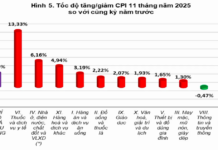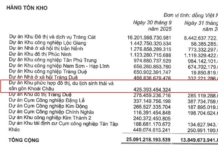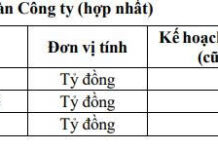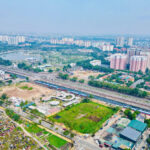
Former General Director of the General Statistics Office Nguyen Bich Lam
The 13th National Party Congress determined the goal of striving to become a developing country with modern industry and high average income by 2030; with a modern, competitive, efficient, and effective management system; economy developing dynamically, rapidly and sustainably, independent, self-reliant on the basis of science, technology, innovation and creativity.
Implementing the important goal of the 13th Party Congress, the Socio-Economic Development Strategy for 10 years 2021-2030 has specified this goal into economic, social indicators that need to be achieved by 2030, such as: Gross domestic product (GDP) growth rate is about 7%/year; GDP per capita at current prices by 2030 will reach about USD 7,500; The proportion of the processing and manufacturing industry accounts for about 30% of GDP; The digital economy accounts for about 30% of GDP; The average labor productivity growth rate is over 6.5%/year; Total social investment accounts for 33%-35% of GDP; Public debt does not exceed 60% of GDP; The contribution of the total factor productivity to growth reaches 50%; The urbanization rate is over 50%….
In order to successfully implement the objectives of the Strategy, based on the scale, structure, potential, competitiveness, independence and autonomy of the economy; based on the growth drivers in each period and experience in leading, directing and implementing socio-economic development; based on the context of international politics and economy and the limitations, weaknesses, difficulties, and risks of the economy, the Government annually develops and submits to the National Assembly for approval the Resolution on the Socio-Economic Development Plan of the year with 15 main indicators of the Socio-Economic Development Plan for the Government to direct its implementation, including:
(1). Gross domestic product (GDP) growth rate; (2). GDP per capita in US dollars (USD); (3). The proportion of the processing and manufacturing industry in GDP; (4). Average consumer price index (CPI) growth rate; (5). The average labor productivity growth rate (NSLĐ); (6). The proportion of agricultural labor in the total social labor force; (7). The proportion of trained workers, including those with degrees and certificates; (8). Urban unemployment rate;
(9). The rate of poor households according to the multidimensional poverty standard decreases; (10). Number of doctors per 10,000 people; (11). Number of hospital beds per 10,000 people; (12). The rate of health insurance participation in the total population; (13). The proportion of communes meeting new rural standards; (14). The rate of collection and treatment of urban solid waste ensuring standards and regulations; (15). The proportion of industrial parks and export processing zones in operation with a centralized wastewater treatment system that meets environmental standards.
Some features of the results of implementing the annual socio-economic development goals in recent years
In recent years, the economic and social activities of our country have taken place in a context in which the world situation is changing rapidly, complicatedly, and unpredictably; difficulties and challenges are greater than opportunities and favorable conditions with increasing risk factors in economy, politics, and society, strongly affecting on a global scale; the world economy has emerged with many factors that have led to fundamental changes in socio-economic activities, trade exchanges, and global competition.
Fierce competition between the two superpowers, the US and China, in terms of ideology, economic structure, along with the fragmented world economy, is threatening the economic and national security of countries, undermining and preventing free trade and capital flows. international.
Along with that, geopolitical conflicts have caused partial disruption of the global supply chain; increasing public debt; the world economy is recovering slowly and unevenly. Inflation in many countries remains high, food and energy prices fluctuate strongly, forcing central banks in many countries to consider raising interest rates to control inflation and temporarily suspending economic recovery. Along with that, the world is facing multiple crises and climate change.
Domestically, the economy faces many challenges, making it difficult to achieve социально-экономического развития socio-economic development goals approved by the National Assembly. In particular, the production and business activities of enterprises in recent years have encountered many difficulties when orders have decreased, and domestic and world demand has recovered slowly and weakly. The growing trend of trade defense investigations into Vietnamese goods makes businesses passive and face many disadvantages in accessing export markets.
Along with the decline in orders, no market for product consumption, businesses fall into a situation of depletion of capital. Corporate bonds maturing, bank loans due for repayment, tax refunds, and slow cash flow have caused many businesses to struggle and slow down production.
In addition, businesses also have to face the inadequacies in the economy’s interior, namely that the institutions and policies are still contradictory, and there are still many barriers to business conditions. In particular, the delay and inefficiency in implementing policies and solutions to remove difficulties, support businesses by some ministries, central agencies, and localities, and a number of cadres, civil servants avoid, shirk their duties, fear of responsibility, and do not decide on matters within their competence have pushed enterprises into increasingly difficult situations. The rate of enterprises withdrawing from the market compared to those entering the market is increasing.
In the difficult context of the world and domestic economic situation, the Government always sets out an action motto, urgently implementing Resolutions, Conclusions of the Party Central Committee, the Politburo, and Resolutions of the National Assembly.
The Government has always resolutely directed all levels, sectors, and localities to focus on implementing synchronous implementation of the tasks and solutions set out in all areas in Resolution 01/NQ-CP on tasks, key solutions to implement the Economic Development Plan. – social and state budget estimates, with the viewpoint and focus in directing and operating and the groups of main tasks and solutions.
Along with Resolution 01/NQ-CP, the Government issued Resolution 02/NQ-CP on the main tasks and solutions to improve the business environment and enhance national competitiveness. The Government promptly develops and promulgates programs, plans, and scenarios to suit the reality.
With flexible, effective management and timely, focused implementation of monetary and fiscal policies; strengthen institutional reform. At the end of the year, out of the 15 socio-economic indicators that have been approved, the social indicators (Indicators 8 to 15) and the CPI growth indicator (Indicator 4) always reach and exceed the plan targets; maintaining macroeconomic stability, inflation controlled, the major balances of the economy are basically ensured; resolutely implementing the work of perfecting institutions, promoting administrative reform, administrative procedures, improving the investment and business environment, strengthening the fight against corruption, negativity, consolidating and improving people’s confidence.
The Government focuses on directing development and completing a system of synchronous strategic infrastructure, environmental protection, and climate change response. The position of Vietnam has been raised, becoming a regional political – economic – security center; firmly maintaining independence, sovereignty, unity, territorial integrity, ensuring national defense, security, political stability, order, and social safety.
The indicators that are not achieved include: Gross domestic product growth rate; GDP per capita; Share of processing and manufacturing industry in GDP; Labor productivity growth rate; Share of agricultural labor in the total social labor force. The unsuccessful targets reflect the inherent problems of the economy that need to be addressed to promote rapid and sustainable growth and lift Vietnam out of the middle-income trap.
In the context of the world having many fluctuations, complexities, and unpredictability, unprecedented, causing difficulties and challenges in implementing the goals and tasks of socio-economic development annually. Under the close leadership and direction of the Party Central Committee; timely and effective coordination between the National Assembly and the Government; the drastic participation of the entire political system; The efforts to overcome difficulties, rise up, and develop the business community and households, in recent years, macroeconomic stability has always been maintained, inflation has been controlled; although economic growth did not reach the target, it was still among the highest in the region and the world.
In 20





































